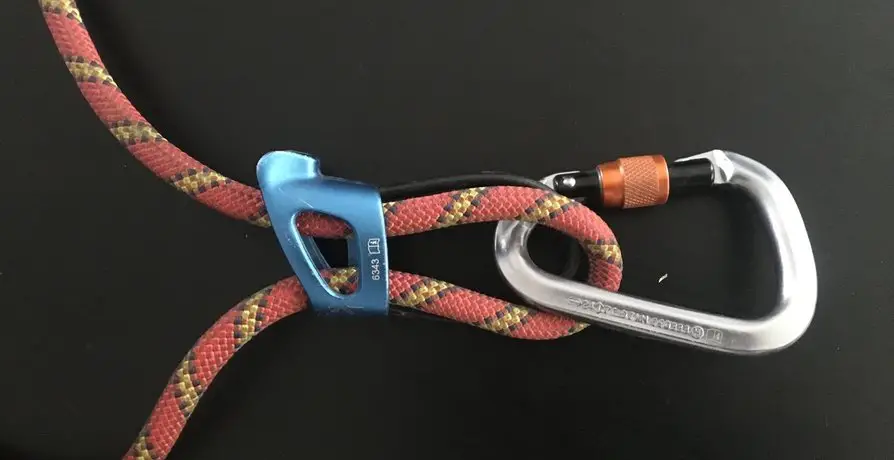
Climbing terminology is difficult sometimes. With so many different pieces of equipment, it’s sometimes difficult to keep track of what you need to complete a certain task.
So, can you rappel with a belay device? Yes. Just about every device you will use for belaying— gri-gri’s, ATC’s, etc— will allow you to rappel. The technique used to rappel will be very similar to the technique used to belay.
Belay devices, at their core, are meant to provide friction within a system to allow you to safely handle someone’s weight when they’re climbing. The same design that allows for you to catch another person’s fall will also provide the type of control needed to safely rappel down a length of rope. However, there are certain scenarios in which you might want to use different devices to belay and rappel.
Rappelling With Your Belay Device
Just about every time you go rappelling, you will do so using a belay device. In fact, there are very few products created specifically for rappelling; they are all belay devices that, with a slight modification to technique, can be used to rappel. Another important point is that you should never rappel with something that isn’t also a belay device.

When performing a rappel using your belay device, you will operate the system in much the same way you did when belaying, only there will be no one else on the rope. Your brake hand— the hand that never leaves the rope— will be the same as is was when you were belaying. You should perform all the same safety checks, including:
- Locking the carabiner that attaches your belay device to your harness
- Tying a stopper knot at the end (or ends) of your rope
- Ensuring that the route is clear of any hazards, including rockfall from above.
The specific techniques used to perform the belay will differ based on what device you are using. Make sure that you are familiar with your device and have practiced using it in a safe environment before you attempt to conduct a full rappel.
As I mentioned in the first paragraph, while almost all belay devices will work for a rappel, there are certain situations in which some may perform better than others. In these types of scenarios, it may be best to carry one device for belaying and another for rappelling.
Different Types Of Belay Devices
Before going in to the specifics of when you may want to carry a supplemental device, it is important to understand the different types of devices that can be used to rappel. There are two main categories that most devices will fall in to:
Friction Devices: These are devices that, when combined with your harness and (usually a carabiner), rely on friction in the system to help you control your rappel. Friction devices are simple, lightweight, and often extremely durable, because they have so few parts. Examples include the Black Diamond ATC and the Petzl Reverso.
Braking Devices: These are devices that use internal components to stop rope from moving through the system. Usually this take the form of some kind of camalot within the system that allows the rope to move in one direction but blocks it from moving in the other. The most common type of braking device is the Petzl gri-gri.
Types of Rappelling
There are two main types of rappels that you will conduct: single rope and dual-rope rappels. The names are fairly self-explanatory, but there are certain details that are important to understand:
Single-rope rappels: These are, as the name suggests, rappels performed with a single strand of rope being fed through the system. They are often anchored at the top through the use of a knot that ties to the rope in place and allows you to lower from it.
Dual-rope rappels: These are rappels in which two strands of rope are fed through the system. The important thing to note is that these two strands often come from the same piece of rope. The rope will be looped around an anchor point at the top of the rappel, with equal lengths dangling down on either side. By feeding both pieces of rope through your rappel device, you can equalize the system and ensure a safe descent.
Which rappel technique you use depends one what situation you are in. If you’re going on a rappelling adventure with pre-set routes, or if you’re caving, it is more likely that you will be using single rope rappels. For climbs and alpine adventures, especially those with multiple pitches, expect to be doing a lot of dual-rope rappels.

The main advantage of a dual-rope rappel is that it allows you to retrieve your rope once the rappel has been performed. This is useful if you need to perform more than one rappel sequentially. There are, however, some disadvantages:
- Performing a dual-rope rappel often limits the distance you can rappel.
- Dual rope systems are harder to ascend.
- Dual-rope technique is more difficult to learn and master
- Dual rope rappels limit the number of devices you can use during your rappel.
Because of the pros and cons, it is clear that there are certain scenarios in which each technique is better. The general rule of thumb is:
- If you are descending first and plan to ascend later, use a single-rope rappel. This is common during caving expeditions.
- If you are ascending first and plan to descend later, plan to use a dual-rope system on your way down. This is most common while climbing.
Now that we understand the different types of rappels and belay devices, we can analyze how different scenarios might affect your selection.
Differing Situations
Again, there is a general rule of thumb that can be applied when deciding which belay device you want to use for your rappel:
In general, braking devices tend to be safer than friction devices because of their auto-blocking features. This means that if, for some reason, your brake hand comes off the rope, the device will automatically catch you and prevent you from taking a potentially harmful fall.
The only issue is that most braking devices are only compatible with a single strand of rope. This means that they are unable to perform dual-rope rappels. Therefor, if you are in a situation in which you know a dual-rope rappel will be necessary, make sure you have an ATC or similar friction system on hand. If you are confident that only single-rope rappels will be necessary, go with the extra safety provided by a braking device.
There is one caveat to this rule. The added safety of braking systems also comes at the cost of complexity. They have more moving parts and, therefor, are more liable to jam in cold weather or averse conditions. Because of their simplicity, friction devices do not face the same problems, and can therefor be considered more adept to handle rappels in extreme conditions.
Carrying Multiple Devices
In a select few scenarios, it may be advantageous to carry more than one rappel device. A few possible scenarios are outline below:
As a backup: As stated above, braking devices have the inherit risk of their components not working or becoming clogged with ice, sand, or dust. When rappelling, it is important to always be prepared for the worst case scenario. Many friction devices are so lightweight that it is worth it to carry them as a back-up should something happen to your primary device.

When performing multi-pitch routes: Almost every multi-pitch route will require a dual-rope belay. Remember, once a single-rope belay has been set, the rope can only be retrieved if the knot at the top of the system is undone. Because of this, they are perfect if descend first and then ascend second. If the descent is your final move, though— such as using a rappel to get to the bottom of a multi-pitch climb— you will have no way to retrieve your rope. This means that, for multi-pitch routes, you would have to leave multiple ropes behind. This is impractical from a financial, environmental, and weight perspective.
In such a scenario, it may be easier to just carry two devices on the multi-pitch climb: a braking device to allow for safer belaying on the way up, and a friction device to allow for dual-rope rappels on the way down.
Related Questions
What’s the best rappelling device? As mentioned in the article above, this depends on what type of rappel you are going to be performing. In my opinion, the Black Diamond ATC offers the perfect mix of versatility, safety, and affordability, and is my go-to rappel device. Bonus tip: pair it with a prusik or similar friction knot to make it just as safe as a braking device
What do you need to rappel? To rappel safely you need a high-quality rope, a rappel or belay device, a harness, some type of anchor for your rope, and the knowledge required to safely use all of your equipment.
